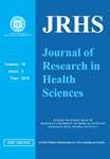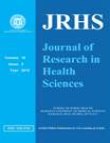فهرست مطالب

Journal of Research in Health Sciences
Volume:16 Issue: 1, Winter 2016
- تاریخ انتشار: 1395/01/29
- تعداد عناوین: 9
-
-
Pages 11-16BackgroundShigella is responsible for high morbidity and mortality among children, yet its true prevalence remains inconclusive. The aim of this study was to determine the actual prevalence of Shigella infection in childhood diarrhea and dysentery cases and assess the applicability of ipaH gene PCR in Indian settings.MethodsThis study was conducted at Maulana Azad Medical College and associated Lok Nayak Hospital, New Delhi, India during 2011-12. A total of 385 children (207 with diarrhea, 118 with dysentery, and 60 matched controls) were enrolled. Stool samples were cultured, and the suspected colonies were analyzed using biochemical reactions and serotyping. Antimicrobial susceptibility testing was done using disc diffusion method. ipaH-gene PCR was performed directly on stool samples collected from 180 randomly selected patients (60 from each group).ResultsShigella was isolated using conventional culture methods in 8.2% (95% CI: 5.1%, 12.8%), 33.1% (95% CI: 25.2%, 42.0%), and 0% in the diarrhea, dysentery and control cases, respectively. High resistance was seen towards co-trimoxazole, nalidixic acid, fluoroquinolones, doxycycline and several beta-lactams drugs. Actual prevalence of shigellosis was determined using ipaH gene PCR to be 18.3% (95% CI: 10.4% 30.1%) diarrhea cases and 56.7% (95% CI: 44.1, 68.4%) dysentery cases. One (1.7%, 95% CI: 0.01%, 9.7%) control specimen also yielded positive result in PCR.ConclusionsCorrect diagnosis of shigellosis is essential to start antimicrobial therapy in selected cases. The prevalence of Shigella / EIEC infection in children is much higher than previously estimated. Despite its high costs and other limitations, we recommend the use of ipaH-gene PCR as a routine tool in the management of childhood acute gastroenteritis cases.Keywords: Shigella, Diarrhea, Dysentery, ipaH, India
-
Pages 17-21BackgroundPulmonary complications, respiratory symptoms and depression are common occurrences which contribute to the morbidity and mortality seen in individuals living with HIV/AIDS. This study investigated the effect of aerobic exercise on the pulmonary functions, respiratory symptoms and psychological status of people living with HIV.MethodsThis study was conducted in Lagos, Nigeria from October 2014 to May 2015. Forty eligible individuals with HIV aged 18 yr and above participated, of which 33 cooperated to the end. They were recruited from the HIV/AIDS Prevention and Intervention Initiative (APIN) Clinic, Lagos University Teaching Hospital, Nigeria and were randomly assigned to either the study or the control group. The study group received aerobic exercise training three times a week for six weeks and counselling while the control group received only counselling. Pulmonary functions, respiratory symptoms and psychological status were evaluated at baseline and at six weeks. Inferential statistics of paired and independent t-test were used to analyse the data.ResultsComparison of mean changes in the pulmonary variables of the study group with those of the control group showed significant differences in all but in the respiratory rate (RR) - [Forced Expiratory Volume in one second: P=0.001, Forced Vital Capacity: P=0.001, Peak Expiratory Flow: P=0.001]. There were also significant differences between the mean changes in respiratory symptoms (P=0.001) and depressive symptoms (P=0.001) of study group and those of the control group.ConclusionsAerobic exercise training significantly improved pulmonary functions as well as significantly reduced respiratory and depressive symptoms in people living with HIV.Keywords: Aerobic exercise, Pulmonary, Psychological status, HIV
-
Pages 22-25BackgroundAccording to the angiographic findings, 3%-8% of atherosclerotic coronary artery patients suffer from coronary artery ectasia (CAE). We conducted this study to estimate the prevalence of CAE among patients who underwent angiography and compared this group with those patients without CAE and atherosclerosis in terms of common coronary heart disease (CHD) risk factors.MethodsThis cross sectional study was conducted in Hamadan Province, western Iran, from March 2014 to March 2015. Data were collected from angiography evaluation and clinical records in Ekbatan Hospital. The patients with atherosclerosis who had CAE were compared with patients who had neither CAE nor atherosclerosis. The categorical variables were compared using chi-squared test or Fishers exact test.ResultOf 2767 patients who underwent coronary angiography, 166 (6.0%) had CAE with atherosclerosis, 2357 (85.2%) had atherosclerosis without CAE, and 244 (8.8%) had normal coronary artery. Compared to normal group, CAE patient were more hypertensive and smoker. Besides, in CAE group the proportion of dyslipidemia was higher than normal subject.ConclusionThe prevalence of CAE in Hamadan Province was in the expected level. Distribution of common CHD risk factors were most prevalent in CAE patient in comparison with normal coronary artery group.Keywords: Ectasia, Coronary Artery, Atherosclerosis
-
Pages 26-30BackgroundThe global prevalence of overweight and obesity had risen in recent decades, and obesity is taken into consideration as a public health concern and a major risk factor of common chronic disease. The objective of the present study was to estimate the prevalence of overweight and obesity and to identify its underlying factors among children 2-6 yr of age in Fars Province, southern Iran.MethodsA total of 8911 children, aged 2-6 yr age, were selected thorough multi-stage sampling in 30 cities of Fars Province in 2012-13. Overweight and obesity status was assessed through comparison by standard BMI for age and for sex percentiles (NCHS/CDC). In addition, socio-demographic measures obtained from structured questionnaire were compared between normal and overweight plus obese (ow/ob) groups. We used backward stepwise Logistic Regression, Chi-square and Independent sample t-test to relate the underlying factors to the nutritional indices.ResultsThe prevalence of overweight and obesity was 5.7% (95% CI: 5.2%, 6.1%) and 5.2% (95% CI: 4.7%, 5.6%), respectively. The ow/ob was significantly correlated with male sex, urbanization, type of fathers occupation, universal education of mothers, the higher birth weight, low access to household facilities, and not using health-care services (PConclusionsThe rate of overweight and obesity in the study population is at an alarming level. Therefore, a preventive program is needed to control ow/ob since early childhood considering the underlying factors for each region and individual groups.Keywords: Overweight, Obesity, Children, Preschool, Prevalence
-
Pages 31-35BackgroundBreast cancer survival has been analyzed by many standard data mining algorithms. A group of these algorithms belonged to the decision tree category. Ability of the decision tree algorithms in terms of visualizing and formulating of hidden patterns among study variables were main reasons to apply an algorithm from the decision tree category in the current study that has not studied already.MethodsThe classification and regression trees (CART) was applied to a breast cancer database contained information on569 patients in 2007-2010. The measurement of Gini impurity used for categorical target variables was utilized. The classification error that is a function of tree size was measured by 10-fold cross-validation experiments. The performance of created model was evaluated by the criteria as accuracy, sensitivity and specificity.ResultsThe CART model produced a decision tree with 17 nodes, 9 of which were associated with a set of rules. The rules were meaningful clinically. They showed in the if-then format that Stage was the most important variable for predicting breast cancer survival. The scores of accuracy, sensitivity and specificity were: 80.3%, 93.5% and 53%, respectively.ConclusionsThe current study model as the first one created by the CART was able to extract useful hidden rules from a relatively small size dataset.Keywords: Breast Neoplasms, Survival, Data Mining, CART, Decision Tree
-
Pages 36-40BackgroundThe occurrence and the mortality related to breast cancer (BC) in Iranian female population has increased over time. Although there are many studies on BC and related risk factors, however, the epidemiological aspects of this melanoma in Iranian females are uncertain. Therefore, the aim of this study was to determine the relationship between demographical and clinical factors on the shape of overall survival (OS) distribution in patients with BC.MethodsThis historical cohort study was carried out using data from 522 participants with BC. Data were gathered from medical records of these patients admitted to Mahdieh Oncology Center of Hamadan Province, western Iran, from January 2000 to August 2011. Kaplan-Meier estimator was used to estimate the survival rates and, censored quantile regression (CQR) to provide in-depth insight in the multivariable association between prognosis factors and survival rates.ResultsPatient's follow-up ranged from around 3 to 197 months. One-, three-, and five-year survival rates were 90%, 73% and 62.5%, respectively. Results of CQR model showed that change in the age at diagnosis, number of involved lymph nodes and tumor size could significantly change the median and some other quantiles of OS.ConclusionsThis study, confirm the importance of early detection of BC and usefulness of CQR because of possible changes in distribution family of survival time.Keywords: Breast Cancer, Survival Analysis, Quantiles
-
Pages 41-45BackgroundThe present study was undertaken to ascertain whether (or not) long term occupational exposure to low (sub-TLV levels) atmospheric concentrations of chlorine gas was associated with any significant decrements in the parameters of pulmonary function and/or increased prevalence of respiratory symptoms.MethodsIn this retrospective cohort study that was performed in 2012, 54 workers of a local chloralkali unit and 38 non-exposed office staff were enrolled and compared. Atmospheric concentrations of chlorine gas were measured by numerous sampling with gas detector tubes. Data on respiratory symptoms were gathered using a standard questionnaire. Furthermore, spirometry test was performed for subjects both prior to and at the end of shift.ResultsMean atmospheric concentration of chlorine gas was 0.27 ±0.05 ppm that was lower than the existing TLV value for this toxic irritant gas. Symptoms of respiratory diseases were significantly more frequent among exposed subjects than in referent individuals. Additionally, mean values of most parameters of pulmonary function including FEV1 (P=0.031), FEV1/FVC ratio (P=0.003) and PEF (P=0.005) were significantly lower than their corresponding values for unexposed subjects. Additional cross shift decrements were also noted in some lung functional capacities, although changes were not statistically significant.ConclusionsExposure to sub-TLV levels of chlorine gas is associated with statistically significant decrements in the parameters of pulmonary function as well as increased prevalence of respiratory symptoms.Keywords: Chlorine, Chloralkali Plant, Respiratory Function Tests, Respiratory Symptoms
-
Pages 46-50BackgroundPoor sleep quality is closely associated with lifestyle habits including use of mobile cell-phones.This study aimed to identify the relationship between sleep quality due to abuse in mobile cell-phones and engagement in social networks.MethodsThis cross-sectional study was conducted on 380 undergraduate students selected by proportional stratified sampling in Qom, Iran in 2015. Data were collected by two statndard questionnaire including Cell-Phone Over-Use Scale (COS) and Pittsburgh sleep quality questionnaire beside the status of usage in cell-phone social networks. T-test, chi-square, Pearson correlation coefficient and multivariate logistic regression were used in data analysis.ResultsThe mean age of participants was 21.8 ±3.2 yr, 69.1% were female, and 11.7% were married. The mean of COS and sleep quality scores were 48.18 ±17.5 and 5.38 ±2.31, respectively. The prevalence of over-use of cell phone was 10.7% (CI 0.95; 8.8%, 12.6%) and the prevalence of poor sleep quality was 61.7% (CI 0.95; 57.1%, 66.3%). The mean of all aspects and total score of sleep quality showed a direct significant association by cell-phone addiction score except sleep duration score that was inversely. Based on multivariate analysis affected to cell-phone addiction, being male gender and studying in general physician level are the most important predictors of poor sleep quality.ConclusionsOver use of internet and social networks via smart phones is related to poor sleep quality and quantity. Predefined sport programs, educational, cultural, and interesting entertainment are the essential needs for all medical students. These interventions are more important especially for male students who have longer educational.Keywords: Sleep, Social Networks, Internet Addiction, Cell, Phone Over, Use, Mobile Addiction, Students


